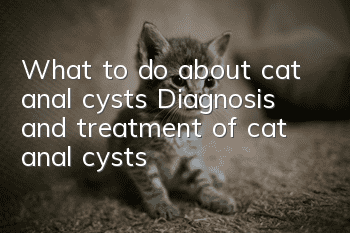What to do about cat anal cysts? Diagnosis and treatment of cat anal cysts!

What should I do if I have anal cyst in cats? Diagnosis and treatment of anal cyst in cats! Anal cysts in cats usually occur in middle-aged or elderly cats. Anal sac diseases that are easily induced are anal sac obstruction, chronic infection and anal sac abscess. Each anal sac is connected to the surface by a small tube; the sacs are lined with abundant glands that secrete fat. These glands produce an oily fluid with a special odor that helps animals create social markings within the group. When the fluid in the anal sac thickens or the duct becomes blocked, the anal sac will become overfilled. As the water in the fluid is reabsorbed, the material components in the anal sac will dry out, and the anal sac will become clogged; severe blockage and infection may cause the anal sac to become clogged. Rupture and abscess of the cyst. Our hospital recently cured a case of anal cyst in a Siamese cat. We would like to share with you the incidence and treatment plan of the disease.
Figure 1 Anal cyst extruded with purulent secretions
1. Incidence and clinical symptoms
According to the pet owner , the cat’s appetite has recently decreased compared to before, and its activity level has also decreased. Yesterday, it was found that the cat had not eaten cat food, was in poor spirits, and looked obviously thin, so it was sent to our hospital for examination. When taking the cat's body temperature, it was found that the skin around the cat's anus was red and swollen, the anal sacs were swollen, and there were purulent secretions and a small amount of blood oozing out. The cat also had difficulty defecation and was slightly constipated.
2. Laboratory examination
The overall condition of the animal in clinical examination was normal, with a moist nose, rectal temperature of 38.2 degrees Celsius (normal), normal breathing, and no vomiting. Signs of diarrhea, desire to drink and urinate are normal, abdominal palpation shows no abnormality, anal examination shows red, swollen and dirty skin around the anus, infection is obvious, slightly lower on both sides of the anus, equivalent to the 4 o'clock and 8 o'clock positions on the clock (anal sac duct) After squeezing, there will be purulent secretions and blood; conduct blood test after venous blood collection.
2.1 The details of the blood test results are as follows:
Table 1 Routine blood tests
Project name | Unit | Detection results | Reference value |
White blood cells | 109/L | 9.0 | 5.5~19.5 |
Red blood cells | 1012/L | 10.6 | 5~11 |
Hemoglobin | g/L | 143 < /td> | 80~120 |
Neutrophils | % | 75 | < p>35~92 |
Basophils | < td width="142" valign="top" style="width:142px;padding:0cm 7px 0cm 7px">0 | 0 | |
| Eosinophils | % | 0 | 0~12 |
Mononuclear macrophages | % | 1 | 0~4 |
Lymphocytes | % | < td width="142" valign="top" style="width:142px;border:none;border-bottom:solid #000 1px;padding:0cm 7px 0cm 7px">20~55 |
Table 2 Blood biochemical tests
Project name | Unit | Detection results < /td> | Reference value |
CA | mmol/L | < p>2.36 | 1.95~2.82 |
CHOL | mmol/L | < p>2.68 | 1.68~5.81 |
CREA | mmol/L | 144 | 71~212 |
GLOB | g/L | 59 | 28~51 |
GLU | mmol/L | 11.31 | 4.11~8.83 | PHOS | mmol/L | 1.53 | 1.00~2.42 |
TBIL | mmol/L | < td width="142" valign="top" style="width:142px;padding:0cm 7px 0cm 7px">0~15 | |
TP ALB ALKP ALT AMYL UREA | g/L g/L U/L U/L U/L mmol /L | 86 27 19 60 488 13.7 | 57~89 22~40 14~111 12~130 500~1500 5.7~12.9 |
2.2 Stool examination
Stool examination showed no occult blood and no other abnormalities.
Figure 3 Sick cat has loss of appetite
3. Clinical diagnosis
(1) Clinical examination and analysis: through perineum and anus Examination of the surrounding area makes the diagnosis. The swollen anus of the sick animal was palpated and squeezed. The animal felt tenderness. After repeated squeezing, there was more purulence in the anal sacs on both sides.Discharge and a small amount of blood flowed out, and the initial diagnosis was an anal cyst.
(2) Analysis of laboratory test results: No obvious abnormalities were found in routine blood indicators; among the biochemical indicators, urea nitrogen and globulin indicators were high, indicating the possibility of infection.
(3) Comprehensive clinical examination, laboratory examination and feeding observation can rule out other digestive system diseases and diagnose anal cyst.
4. Clinical treatment
4.1 Drug treatment
Disinfect the area around the anus of the sick animal on the day of admission. First, squeeze the blocked anal sac ducts on both sides of the anus. After the purulent secretions in the anal sac are squeezed out, rinse with hydrogen peroxide and normal saline. Finally, pour levofloxacin ointment into the anal sac, once in the morning and once in the evening, and continue Take medication for one week. In order to shorten the recovery time, a quarter of each penicillin and streptomycin were injected intramuscularly every day for one week. On the third day of medication, the affected area of the anal sac showed obvious signs of improvement. On the fifth day of medication, the overall condition of the sick animals improved significantly and their activity level increased. After 7 days, the sick animals basically recovered and were discharged.
4.2 Dietary adjustment
Feed prescription cat food.
4.3 Postoperative care
After coming to the hospital every seven days, the animal’s anal sac area will be squeezed once to empty the contents to prevent obstruction of the sac duct, and levofloxacin ointment will be applied appropriately to the original affected area. Ensure the animals drink enough water.
5. Summary
5.1 Causes of anal cysts
① Seasons change, and the breeding environment is prone to change due to rainy season and other reasons Moisture. It is easy for bacteria to breed, thus inducing anal sac disease in sick animals.
② Pet owners often feed meat to animals. The feed is relatively simple. High-protein and high-fat diets may cause excessive secretion of glands in the anal sac wall, causing obstruction of the anal sac and accumulation of secretions in the sac. The anal sacs swell and cause an inflammatory reaction.
5.2 Types of anal sac diseases
Anal sac diseases are generally divided into three categories, namely portal sac obstruction, anal sacitis and anal sac abscess, with little difference in clinical symptoms. Each condition represents a different presenting aspect of the same disease process rather than a separate disease. Anal obstruction is usually characterized by thick dark secretions; anal sacculitis is characterized by lighter-colored milky yellow secretions, which may bleed in severe cases; anal cysts are characterized by elevated body temperature and inflammation. The animal disease in this case mainly manifested two symptoms: anal sac obstruction and anal sac inflammation.
5.3 Prevention and treatment,
Emptying the anal sacs can relieve animal pain, actively disinfect the affected area, and combine antibiotic treatment to control infection; adjust diet and avoid high blood pressure during the disease. Fat and high protein, improving the feeding environment and keeping it dry and ventilated can help the animals recover.
6. Summary
The incidence of anal sacs in cats is low, among which obstruction of the hepatic portal sac duct is the most common. When unilateral anal sac infection occurs, the contents of the contralateral anal sac duct should also be emptied to prevent reinfection; active emptying of the anal sac can prevent the disease and reduce its frequency. Generally, when purulent secretions are blocked, squeeze the anal sac. The process of pressing the anal sac must be slow and cannot be done roughly.
- Why do girls like to keep cats?
- Can cats carry rabies virus without getting sick?
- Necessary items for cat bathing
- Advantages and Disadvantages of Bathing Cats
- The cat keeps meowing
- Learn about the symptoms, treatment and management of high blood pressure in cats!
- Can cats be kept free-range? Precautions for free-range cats
- Why do cats like to bite people’s hair?
- How do cats recognize their owners?
- Why do cats like to step on milk? What is the reason and meaning behind it?



